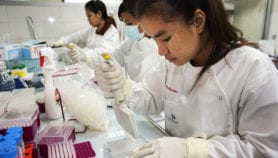Send to a friend
The details you provide on this page will not be used to send unsolicited email, and will not be sold to a 3rd party. See privacy policy.
The latest World Development Report is a timely reminder that innovation has a key role in alleviating poverty. One implication is that effective mechanisms for putting research into practice are essential for achieving the UN’s Millennium Development Goals.
Microsoft founder Bill Gates had a simple message when he addressed students at the University of California in Berkeley last week. Technological innovation, he said, was not a ‘zero-sum game’ in which the rich get richer while the rest of the world drops behind. Rather, it was the prime motor of economic and social development for all — as evidenced by the extent to which the strength of the US economy is largely due to the strong links between the country’s research universities and its industrial corporations.
Gates’s comments were aimed at critics of the recent growth of developing country economies, particularly China and India. He described as "a little scary" those who expressed fears that the economic success of such countries risked undermining the economic strength of the United States: "It is not like a war where you have one winner and one loser," said Gates. "China and India are the big change engines for the years ahead, and as we embrace that and understand our new role in that, that’s the path forward."
The same message, even if expressed in less colourful language, lies at the heart of this year’s World Development Report, published earlier in the week by the World Bank under the title A Better Investment Climate For Everyone. The report — which focuses on the importance of encouraging innovation as a route to economic growth — admits that mistakes in this field have been made in the past (for example, by governments that have sought to build an industrial strategy around ‘picking winners’).
But — like Gates’s comments — it also highlights an essential message for all those concerned about the role of science in the development process. Namely, the most effective strategies for achieving this goal are not those that assume governments and their agencies have the best or most appropriate answers about how this should be done. Rather, they are strategies that provide a supportive environment for individuals, institutions and enterprises that are dedicated to finding the best ways of putting research results into practice.
Innovation and poverty alleviation
Achieving this, of course, is much more of a challenge than its sounds. For the ‘supportive environment’ has many dimensions, and achieving it can therefore involve major political challenges. A survey carried out for the report, for example, found that one of the biggest barriers to innovation was a lack of confidence that governments would respect their own laws protecting investments; in Bangladesh, such a concern was expressed by more than 80 of those interviewed.
Another significant worry is the level of corruption that continues to operate in many developing countries. Leave aside the moral (or even economic) dimension of a situation in which, according to the report, "the majority of firms in developing countries expect to pay bribes when dealing with officials". Equally concerning is the fact that the mechanisms by which corruption operates can distort technological priorities, for example by skewing investment towards large-scale projects such as dams (for which official permission can require large pay-offs), rather than small-scale initiatives that may often be more directly appropriate to local needs.
But there are two specific dimensions of the report’s argument which, although only referred to briefly in the document itself, should be of central concern to all those engaged in promoting the role of science in development. The first is that fact that — as most industrialised nations have come to recognise in recent years — the existence and availability of relevant scientific and technological knowledge is one of the most important components of the supportive environment that successful innovation requires. However obvious it may appear, this is a message that still has to be acknowledged by many developing countries in their domestic priorities.
The second dimension, equally essential (but equally often overlooked), concerns the mechanisms needed to ensure that scientific knowledge is put to effective use. Economic and social development not only requires a physical infrastructure, such as the roads and telecommunications needed to transport goods and information to where they are needed. Equally important is a parallel ‘virtual infrastructure’, linking universities, corporations and policy-making bodies in ways that ensure scientific results and technological information also reaches its targets effectively.
There are many development-related debates to which these arguments are directly relevant. But perhaps none are currently as important as that over the strategy needed to achieve the Millennium Development Goals. As the draft summary of the report of the Millennium Commission — which is currently being made available for public comment — points out, substantial extra investment in the research that underpins such the goals is essential if they are to be achieved (See "’Ending poverty’requires US$70 billion in research aid’" NW1635).
The draft summary also pinpoints the need for the necessary infrastructure to support scientific and technological efforts in developing countries. However, the main examples that it calls for remain in the physical sphere (such as investment in science, technology and engineering institutions). Hopefully the final version, perhaps drawing on the message of the World Development Report, will also underline the need for governments to do more to link research to practice in this field — or, to put it another way, to take policy initiatives specifically designed to promote pro-poor innovation.
Learning from the past
If there is a major weakness on the World Bank’s report, it is the relative neglect of any detailed consideration of how this pro-poor innovation might be achieved (beyond just providing an environment in which it can take place). History already shows us that it would certainly be wrong, for example, to believe in unbridled innovation as the answer to alleviating poverty.
Furthermore, as countries like China and India are already finding to their cost, rapid industrialisation can have unwanted side effects — from scarcity of resources to health-destroying pollution. Governments continue to have a major responsibility to ensure that innovation takes place within a regulatory framework that is sufficiently strict, and sufficiently rigidly enforced, to avoid the costs outweighing the benefits.
Linked directly to this is the danger of formulating innovation policy around a one-dimensional view of human progress. Not all technological products are, by definition, desirable (even those for which a market exists). And modern technologies developed in advanced scientific laboratories are not always the most appropriate solutions to local needs and problems. Technological innovation must be seen as a social process, in which the social factors play as important a role as the market in formulating user demand.
Such caveats, however, should not be allowed to undermine the central message of the World Bank report, namely that human ingenuity, whether in farmers or small-scale entrepreneurs, lies at the heart of the development process. The most effective thing that governments can do if they wish to promote development is to provide an environment in which this ingenuity can flourish, while ensuring that it does so to the benefit of the whole community.
Only if policies for the support of science and technology can be formulated on that basis — and if policies in other areas recognise the central role of science and technology in achieving their objectives — does the elimination of global poverty stand a chance of becoming a practical proposition.













